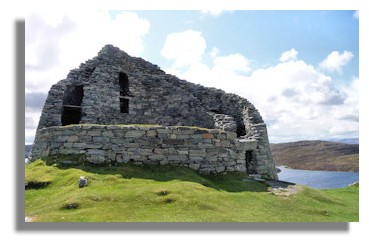Places to Visit in Scotland
- Dun Carloway Broch

Illustration of Inside a Broch
Brochs

A Broch is an Iron Age drystone (no mortar or cement holding the stones together) tower with the outer stonework formed from two walls with space between to allow for a stairway, which also helps to tie the two walls together. Structures of this type are found only in Scotland. They include some of the most sophisticated examples of drystone architecture ever created.
I've always been fascinated by the brochs that can be found near the coasts in the far north west of Scotland and on the Western Isles and Orkney and Shetland islands. But being so remote from where I live in the central lowlands, I never expected to be able to visit them. Then the opportunity arose for a day trip to Lewis and Dun Carloway broch was high on the agenda for places to see during the tour round the island.
History

It was once thought that brochs had been built as a defence by Viking raiders or even by the Vikings themselves. It wasn't until late in the 19th century that it was established that they were much earlier than that, from around 600BC to the last century BC. Initially, archaeologists thought that such advanced structures would have to have been created by invaders from the south - nobody considered that this backwater of civilisation could come up with such a novel structure. But as there is no evidence of brochs anywhere else in Europe, it had to be accepted as an indigenous invention. Indeed, more recent excavations in Orkney show that the communities there began building massive stone-walled round-houses around 600BC which had timber supports for the roof. The ground floor was often poorly finished with outcrops of rock and may have been used mainly for housing cattle, with human habitation beginning on the first floor and also on higher levels - reached by that internal stone staircase between the walls. The structures needed a lot of internal timber - placing significant demands on a material that is in short supply in the Western and Northern isles.
Although brochs would have provided some protection from hostile invaders, they were not as defensible as traditional castles and were probably built more as a symbol of wealth and power. The number of brochs on the island of Barra in the Western Isles suggests that most landowners (as distinct from tenant farmers) had a broch, much as 19th century gentry had their mansion house.
Dun Carloway
 Dun Carloway broch is one of the best surviving examples in the Western Isles, possibly because it was one of the last to be built. Parts of the original wall still reach as high as 9 metres (nearly 30 feet) tall. Dun Carloway was probably built sometime in the 1st century BC, and radiocarbon dating evidence shows that it was last occupied around 1300 AD.
Dun Carloway broch is one of the best surviving examples in the Western Isles, possibly because it was one of the last to be built. Parts of the original wall still reach as high as 9 metres (nearly 30 feet) tall. Dun Carloway was probably built sometime in the 1st century BC, and radiocarbon dating evidence shows that it was last occupied around 1300 AD.
At the base, the broch is around 14 to 15 metres (45 to 50 feet) in diameter and the walls are around 3 metres (10 feet) thick. It has a circular plan and hollow walls with a stairway between them and was built without mortar. It probably had internal wooden floors and partitions and a thatched roof.
I've collected more photographs of Dun Carloway in a YouTube slide show
See also the Dun Carloway Broch Location Map on Google Maps (you can zoom to increase/decrease the scale of this map, if required).



